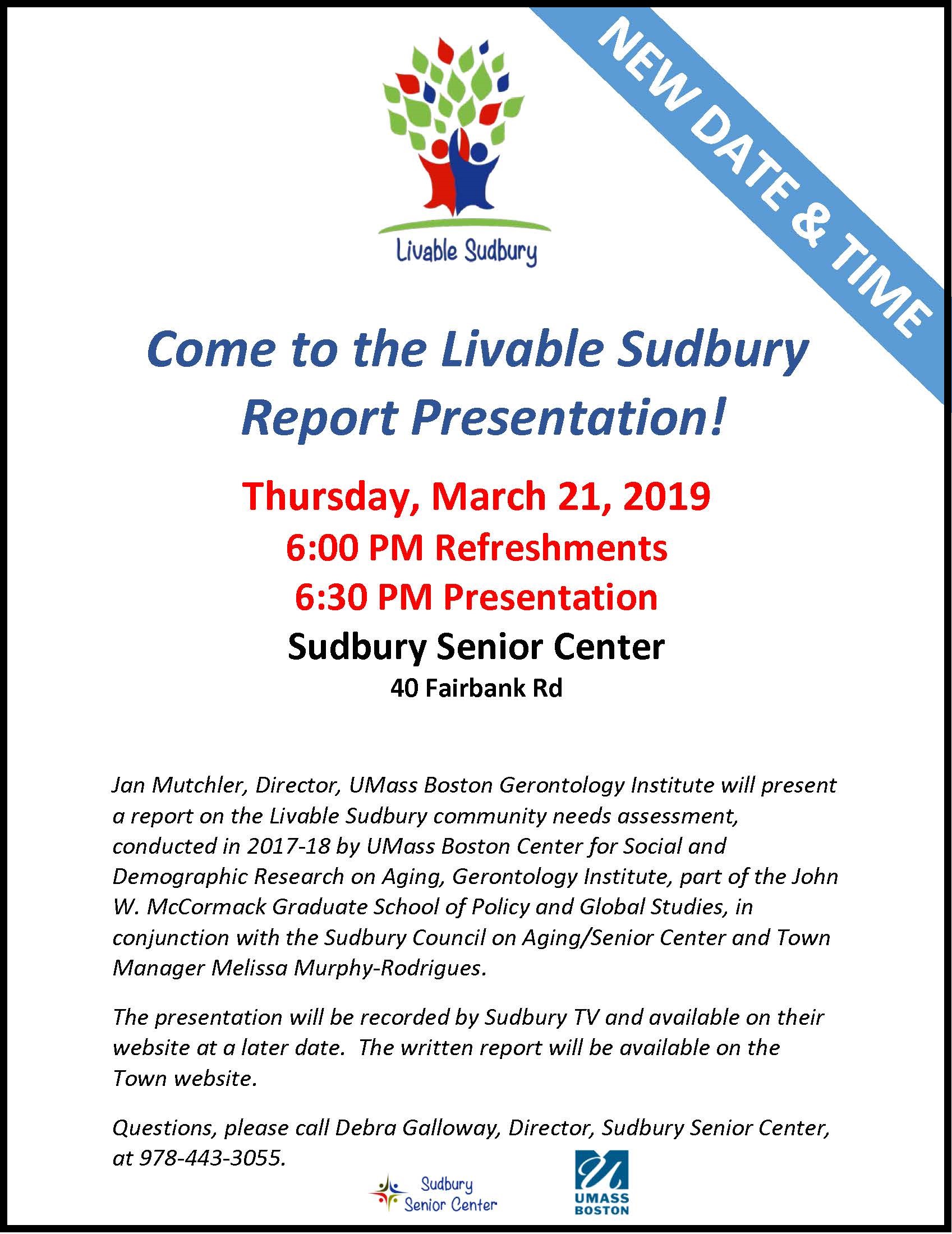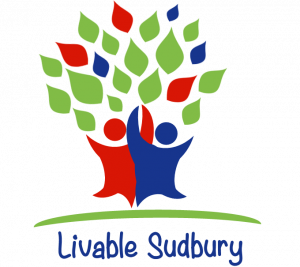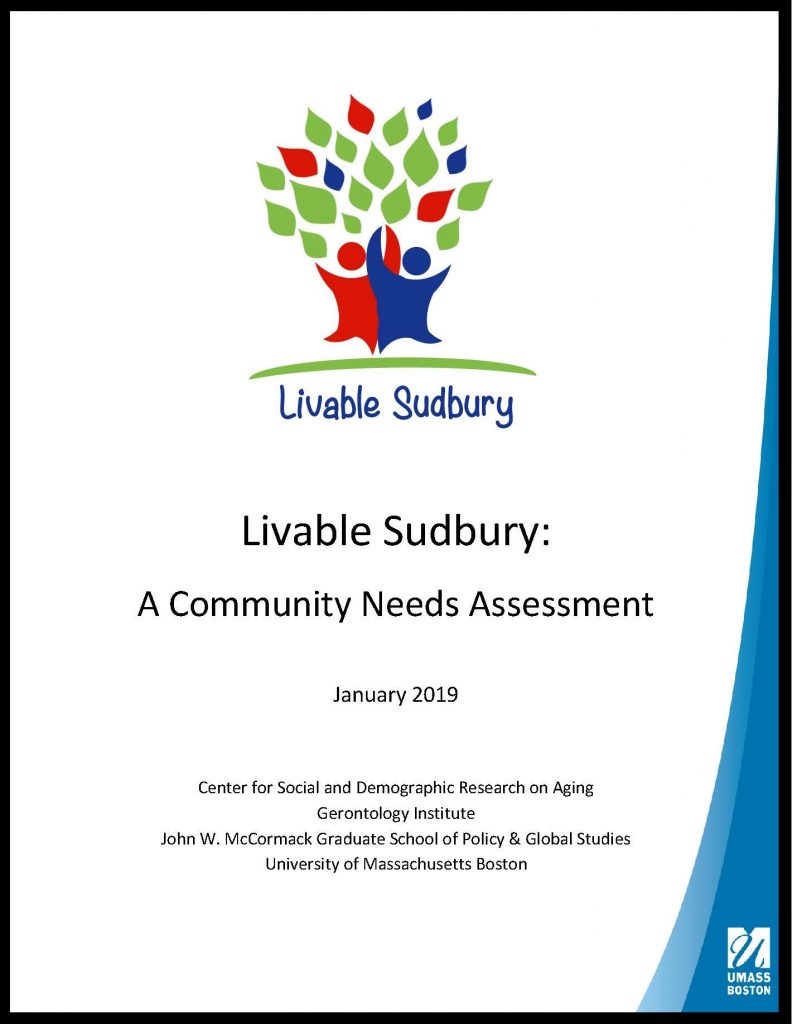Livable Sudbury: Report & Information

The final report of the Livable Sudbury community needs assessment is now available.
The Study was initiated as part of the effort to work toward the goal of a more age and dementia friendly, or Livable community.
The community assessment report and includes the results of survey, focus groups, interviews, document review, and forums, conducted in collaboration with Jan Mutchler, Professor of Gerontology and Director of the UMass Boston Center for Social and Demographic Research on Aging, and Caitlin Coyle, Research Fellow at the CSDRA. Click below to view the report.
Livable Sudbury Survey Report Presentation was held on Thursday, March 21, 2019 at 6:00PM at Senior Center. Please see flyer below for details.
Sudbury is the 234th community to enroll in the AARP & World Health Organization Network of Age-Friendly Communities. AARP’s age-friendly network encourages states, counties, cities, towns and rural areas to prepare for the rapid aging of the U.S. population. The network encourages communities to take action and pay increased attention to the environmental, economic and social features that encourage greater age integration and diversity and create a community that supports residents from the cradle through retirement.
Livable Sudbury Survey
The town of Sudbury, in partnership with the John W. McCormack Graduate School of Policy & Global Studies, UMass Boston, gathered feedback from residents ages 18 and older. The purpose of the survey was to understand people’s needs and to create/improve programs and services that ensure Sudbury remains a vital and livable community for everyone. The survey was the culmination of data gathering that began last fall. Results from the survey and all of the consultants’ work on Livable Sudbury will be made available this winter.
Report Presentation
Jan Mutchler, Director, UMass Boston Gerontology Institute will present a report on the Livable Sudbury community needs assessment, which conducted from 2017-2018.
Livable Sudbury Report Presentation
Thursday, March 21, 2019
6:00PM
Senior Center, Pines Room

What is a Livable Community?
Launched in April 2012, the AARP Network of Age Friendly Communities is an independent affiliate of the World Health Organization’s Age Friendly Cities and Communities Program, an international effort launched in 2006 to help cities prepare for the growth of the older adult population.
Read more about Sudbury’s entry into the program as well as current and future initiatives in LIVABLE SUDBURY: PROCESS FOR MOVING FORWARD.
With the age-friendly program, AARP helps participating communities become great places for people of all ages by adopting such features as walkable streets, better housing and transportation options, access to key services, and opportunities for residents to participate in community activities. Enrollment in the network provides member communities with the resources to become more age-friendly by tapping into national and global research, planning models and best practices.
The Livable Sudbury assessment is part of a broader initiative: Sudbury and 13 other towns in our region have been accepted into membership in the AARP-World Health Organization’s network of livable communities.
A livable community can be defined as a place that enables and engages residents of all ages—encouraging adults and children to enjoy, explore, and access the resources for staying involved with friends and neighbors, for learning and growing, for helping and being helped, and for interacting with their community in meaningful ways.
The concept of livability is based on an international study conducted by the World Health Organization (WHO), the Global Age-Friendly Cities project, undertaken in 33 cities in 22 countries. The research concluded that a livable community provides “the structures and services to support residents’ wellbeing and productivity” and their participation in and contribution to the vibrant life of the community (Global Age-Friendly Cities: A Guide, 2007).
Eight features collectively support and enhance the livability of communities. As you think about Sudbury’s strengths and opportunities for improvement, what would your priority ranking be for strengths? For improvement?
- Outdoor spaces and buildings
- Transportation
- Housing
- Social participation
- Respect and social inclusion
- Civic participation and employment.
- Communication and information
- Community and health services.
Transportation
In March, Sudbury (the lead municipality), Acton, Carlisle, Concord, Maynard, and Westford applied to the Metropolitan Area Planning Council for technical assistance. Their proposal is a one-year pilot based on an innovative model. The towns want to join with area taxi, bus, and livery companies, to build a crucial piece of multi-modal transportation infrastructure in this car-dependent region. The proposal has already received the support of the 495 MetroWest Partnership, which addresses regional needs by means of public-private collaboration to enhance economic vitality, improve quality of life, and sustain natural resources. And, the proposal is a vital element in Sudbury’s livable network membership, with its focus on housing and transportation.

Event Details
| Event Start: | Thursday, March 21, 2019 (6:00 pm) |
|---|---|
| Event End: | Thursday, March 21, 2019 (9:00 pm) (Expected) |
| Location: | Fairbank Community Center - Senior Center Pines Rm. (1958 to 2023) |
| Department: | Select Board's Office |
| Notes: | RESCHEDULED DUE TO SNOW: Results of the Livable Sudbury community needs assessment will be presented on THURSDAY, MARCH 21 at the SENIOR CENTER, starting at 6:00PM. |
| Download: | Download this event to add to calendar (.ics) |

